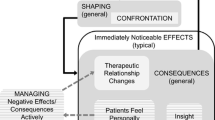Abstract
This paper considers the use of confrontation as a part of group treatment. When done carefully, confrontation leads to expanded awareness by the members and strengthens group cohesion. When done awkwardly, it leads to increased resistance and defensiveness. The author explores ways in which confrontation can be used to challenge discrepancies, distortions, games and smoke screens, and resistance. There is also a discussion of therapeutic guidelines for the practitioner.
Similar content being viewed by others
References
Berenson, B. and Mitchell, K. (1974)Confrontation for Better or Worse. Amherst: Human Resource Development Press.
Carkhuff, R. (1969)Helping and Human Relations: A Primer for Lay and Professional Helpers. Vol. I: Selection and Training and Vol. 2: Practice and Research. New York: Holt, Rinehart and Winston.
Douds, J., Berenson, B., Carkhuff, R., and Pierce, R. (1967) In search of an honest experience: Confrontation in counseling and life. In R. Carkhuff and B. Berenson,Beyond Counseling and Therapy. New York: Holt, Rinehart and Winston, pp. 170–179.
Egan, G. (1970)Encounter: Group Processes for Interpersonal Growth, Belmont: Wadsworth.
Egan, G. (1975)The Skilled Helper: A Model for Systematic Helping and Interpersonal Relating. Belmont: Wadsworth, p. 167.
Gendlin, E. T. (1970) A short summary and some long predictions. In J. T. Hart and T. M. Tomlinson (eds.),New Directions in Client-Centered Therapy. Boston: Houghton Mifflin.
Greenspan, R. (1967)The Technique and Practice of Psychoanalysis, Vol. I. New York: International Universities Press.
Kennedy, E. (1977)On Becoming a Counselor. New York: Seabury.
Lang, R. (1973)The Technique of Psychoanalytic Psychotherapy. Vol. I. New York: Jason Aronson, p. 421.
Reid, K. (1977A) Nonrational dynamics of the client-worker interaction.Social Casework 58 (10), pp. 600–606.
Reid, K. (1977B) Worker authenticity in group work.Clinical Social Work Journal 5 (1), pp. 3–16.
Rogers, C. (1970) Looking back and ahead: A conversation with Carl Rogers. An interview by Joseph Hart. In J. T. Hart and T. M. Tomlinson (eds.),New Directions in Client-Centered Therapy. Boston: Houghton Mifflin.
Schafer, R. (1983)The Analytic Attitude. New York: Basic Books, p. 156.
Seligman, M. (1975)Helplessness. San Francisco: W. H. Freeman.
Weiner, I. (1975)Principles of Psychotherapy. New York: John Wiley, p. 118.
Yalom, I. (1970)Theory and Practice of Group Psychotherapy. New York: Basic Books, p. 24.
Author information
Authors and Affiliations
Rights and permissions
About this article
Cite this article
Reid, K.E. The use of confrontation in group treatment: Attack or challenge?. Clin Soc Work J 14, 224–237 (1986). https://doi.org/10.1007/BF00755855
Issue Date:
DOI: https://doi.org/10.1007/BF00755855




